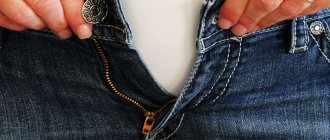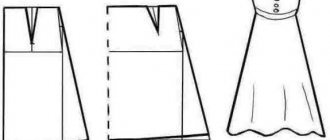How to make jeans soft?
Classic denim is stiff, dense and rough. This often causes severe discomfort and irritation, especially in children. Over time, the clothes will become softer, but it is better not to wait, but to immediately ensure comfortable wear. There are many ways and folk remedies to make jeans soft at home.
Rules for the first wash
To keep your jeans soft, wash them immediately after purchase. Clean according to the following instructions:
- Turn your pants inside out.
- Fill the washing machine with cold water, preferably make a half load and set the cotton wash cycle. When the water is full, immerse your jeans in it. When loading frontally, it is impossible to draw water, so just put the clothes in the drum.
- Pour in the softener and mix it with water. The use of powders is not recommended for the first wash. When front loading, add softener to the powder container so it can work on the jeans during the wash process.
- Wait until the pants are completely saturated with water. Then close the lid and turn on the wash.
- If the fabric is very hard, stop the machine immediately after the cleaning process (before draining the water). Add another portion of softener and repeat washing 3-4 times. For moderately hard fabrics, allow the machine to complete the entire wash cycle.
You need to dry clothes inside out at a low temperature; set the mode for delicate fabrics. Also add rubber or wool balls that will hit the fabric and make it softer. These products are sold in hardware stores and are inexpensive.
Roll the dried jeans from the bottom to the waist. Weigh down the clothing with some weight. You can unfold it only after the fabric has cooled.
Washing with shampoo and conditioner
Subsequently, to soften or maintain the softness of the fabric, wash clothes with baby shampoo and conditioner.
Iron and starch
Algorithm of actions:
- Place the garment right side out on a flat surface.
- Make a mixture of 1 tbsp. starch per 2 liters of water. You can buy a ready-made product at a household chemical store.
- Spray the solution onto the material and go over the treated areas with an iron.
Vinegar and salt solution
This processing method is applied immediately after purchasing clothes. Instructions:
- Pour hot water into a basin and dissolve a few tablespoons of table salt in it. After stirring thoroughly, add a little more water.
- Immerse your jeans in the solution. Add water as needed to ensure the clothing is completely submerged.
- Soak the product for 1-2 hours.
- Remove the item and rinse with vinegar essence. The solution is prepared at the rate of 1 glass of vinegar per 10 liters of water.
- Leave the pants in the liquid for 2 hours.
- Rinse clothes thoroughly in cool water and dry.
After drying, wash the treated jeans in a washing machine using baking soda and powder.
Sandpaper
The method below is not suitable for thin fabrics as they are prone to holes.
To soften the material, turn the garment inside out and place it on a smooth, flat surface. Sand over the entire surface of the jeans using a back-and-forth motion. Almost immediately you will notice the formation of clumps of cotton fibers. Don't worry, this is a normal process.
After treatment, shake the clothes well.
Instead of sandpaper, a pumice stone or razor will do. Carry out manipulations carefully to prevent holes from appearing.
Softening in everyday life
If you wear clothes as often as possible, they will stretch and become softer. For an accelerated effect, wear jeans while cycling. After intense bending of the legs, the item is subjected to additional mechanical stress and becomes softer. Take at least 30 minutes to “break in” your new jeans.
In everyday wear, periodically press your knees to the floor. To keep your pants soft, wash them every 5-10 days of active wear.
Return to blog
Adding width to the hips
To add width at the hips, an insert along the entire length of the skirt is needed. In this case, use a detachable zipper sewn into the back.
- Take measurements of your waist and hips. Divide the difference in volumes by four. The resulting figure will be equal to the required allowance.
- Open the side seams . You will make your task easier if you use a special steamer.
- Strip the seams of old threads.
- Iron them using the steam setting. This will help get rid of machine stitch marks.
- Match the side seams . Use a bar of soap to mark the new measurements on the fabric.
- Sweep them with a simple stitch.
- Machine stitch the details.
- Press the new side stitches.
Don't touch the grooves, leave them the same. Open the belt along the longitudinal seam, cut off the button fastener. Baste the waistband again, taking into account the spaced side width. Sew on a machine.
Steaming with an iron
Option for stretching stretch pants on the calves. Instructions:
- Place the item on the ironing board and cover with gauze.
- Using an iron with a steamer, iron the areas that need to be expanded for 10–15 minutes.
- Periodically pull the fabric to the sides with your hands.
- Put your pants on while they are still damp.
- Walk until the matter cools down.
- Air dry.
The method will help increase the width of the treated areas to 4 cm. Disadvantages:
- difficult to cope on your own;
- you can ruin the thing;
- risk of burns.
- Salicylic acid for the face: uses and reviews
- How to treat cervical osteochondrosis
- Salad with green peas: recipes with photos
Using a waist stretcher
Expander-spacer for increasing the belt. How to use:
- Soak buttoned stretch pants in hot water.
- Insert the extender.
- Using the lever, gradually expand the device.
- Secure it to the maximum.
- Let dry.
The expander works well to stretch out skinny jeans. Flaws:
- after each wash, the procedure must be repeated;
- there is a risk of tearing the item;
- Not suitable for increasing length, fullness in the legs.
Preparing for work
Before you begin restoration, it is important to evaluate all the pros and cons. To do this, you first need to carefully examine the thing. The most common way to add inches to the width of a garment is to use seam allowances.
Important ! If the product will be placed along the side seams, compare their shade with the color of the main fabric. The color of the allowances must match the front side.
The seam allowance should be wide enough to accommodate the new side stitches.
It is also necessary to determine the degree of wear and type of product. There are fabrics that are very sensitive to sewing needles. They leave noticeable holes. Unfortunately, it is impossible to get rid of them, so it will not be possible to widen such a skirt while maintaining an attractive appearance.
The material of the skirt can be convex, voluminous, for example, corduroy, velor, ribbed. This should definitely be taken into account. Additional inserts should under no circumstances violate the integrity of the pattern .
If the condition of the item satisfies the above conditions, feel free to proceed with the alteration.
Bottom extension
And if the skirt widens downward, for example, a flare? This can be expanded by cutting off the top, narrowest part.
Naturally, the skirt will lose a little length, but you will be able to wear it .
Pre-punch the zipper to avoid cutting it. And then save and transfer to the modified model.
Advice. If you need to remake a godet style made from wedge inserts, you can make the skirt wider by adding the same detail.











